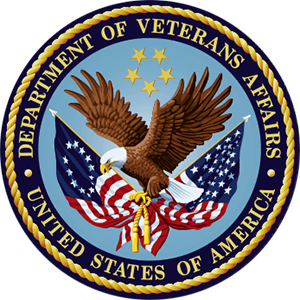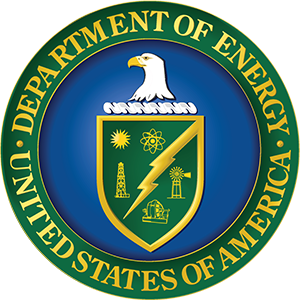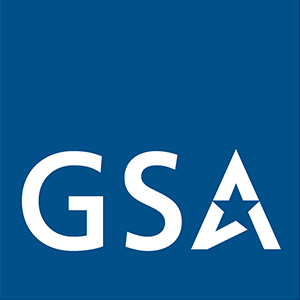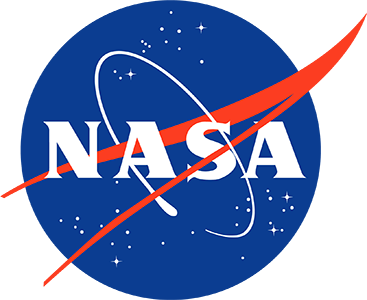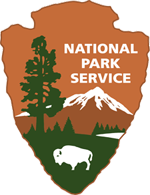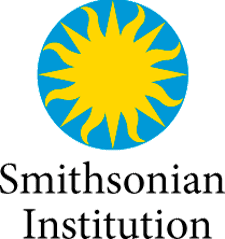Introduction
Within This Page
A new science building can transform a college or university physically, socially, educationally and culturally. A leading-edge facility expresses institutional vitality and commitment to the sciences, attracting exceptional faculty and students while capturing broad-based community support.
Description
Science and research centers are highly valued by the community—as educational resources for K–12 faculty and students and as a destination for the greater community. At The University of Texas at Arlington, the planetarium provides a riveting stage for presentations and lectures to science and humanities students, and stays heavily booked hosting local groups of all ages.
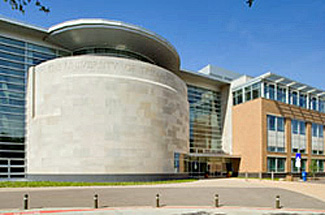
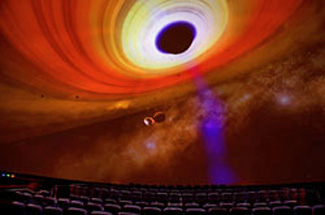
UTA Planetarium serves as a gateway to campus and exciting community destination.
At Birmingham Southern College's Elton B. Stephens Science Center, public spaces, including the large atrium and its auditorium, combine with classrooms and seminar rooms to provide an ideal environment for educational and scientific conferences throughout the year.
Science buildings often complete or enhance a large section of campus, better organizing and unifying the institution.
The new science building at Winona State University connects the schools of engineering and nursing to all the sciences, while the understated exterior carefully transitions from the smaller-scale neighborhood on one side to the main campus pedestrian pathway on the other.
The Klaus Advanced Computing Building at the Georgia Institute of Technology established a new hub for campus activity. A major pedestrian sidewalk passes through the building, seamlessly connecting key campus components and making research and teaching activities easily accessible to all. Additionally, an elevated walkway spans several buildings, connecting disciplines and the wide-ranging activities of the larger community. The building's public spaces were intentionally layered and distributed to reinforce the interdisciplinary nature of teaching and research and to provide unique and varied spaces for groups, large or small, to join together to brainstorm or just relax. The project also created 550 underground parking spaces, exchanging surface parking for green space and future building pads.
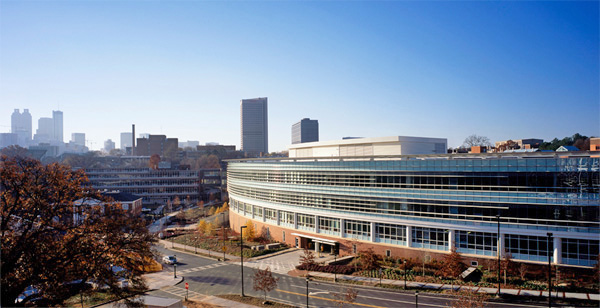
The Klaus building is the gateway for all students entering the research campus.
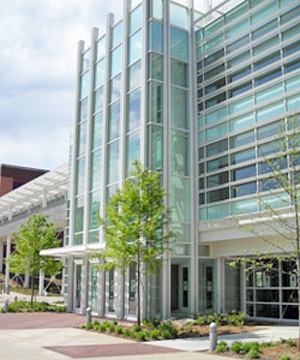
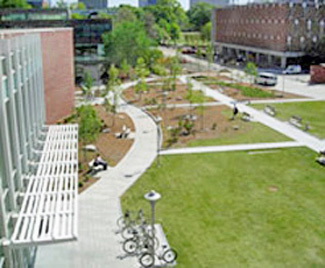
An upper-level bridge in the Klaus building atrium leads to sister buildings, connecting disciplines and strengthening community.
Outside of Georgia Tech's Klaus building, students gather in new green space created by placing parking under the building.
The intrinsic and public relations value of a new science building can be maximized when the institution concurrently elevates its values or mission. The completion of Georgia Tech's Klaus Advanced Computing Building coincided with the rollout of a dynamic new curricular model. The freshness of the new instructional model combined with the highly anticipated facility helped attract a talented and diverse pool of students and professors.
Site and Building as Teacher
Visible indoor and outdoor learning activities help build community memory and demonstrate the dynamic nature of science. Entrances and public greeting spaces, in particular, must surprise and delight to make an unforgettable impression.
At Winona State University's science building, public displays work together beautifully to teach science 24/7. The atrium holds a large auditorium whose atrium-side wall is a mock-up of the shape, texture and geology of the bluffs along the Mississippi river. In the same space, a seating bench that displays the original map of the constellations is surrounded by key symbols of all disciplines in the building. Flat-panel displays provide information about special events. Large windows open into a geosciences lab displaying multiple Plexiglas flume research apparatus, modeling the dynamic effects of water on the earth's surface. A geology and botany rock garden enables students to study indigenous flora and uncover relationships across geologic time modeled by careful placement of exposed and buried rock specimens.
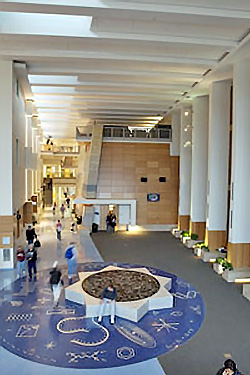
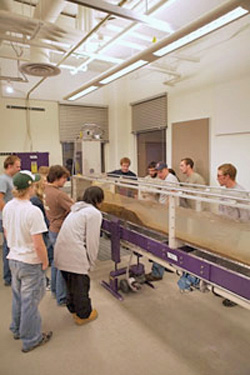
Winona States University's geology wall, star bench and science symbols teach 24/7.
A geology flume lab was made possible by space protected for its use and a faculty grant award. The flume also can be viewed from the public atrium.
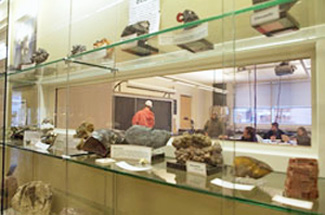
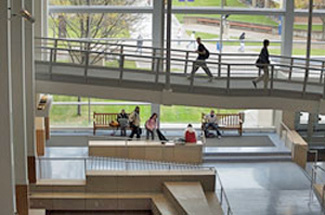
This window holds geology lab specimens for all to see and allows onlookers to view the active learning beyond. (WSU)
At Winona State University dynamic circulation patterns build community across levels and between disciplines.
Easy access to technology—ranging from power and wireless networks to interactive scientific displays—creates dynamic shared spaces (whether in the student center, the local café or in an outside courtyard) and make powerful impressions on visitors, future faculty, students, parents and funding partners. Circulation patterns outside and inside buildings should be "paths to discovery"—critical organs that promote the life and health of the scientific body, bridge disciplines and create excitement. A mix of scientific displays, interactive flat-panel screens (and the technologies that will replace them) and real-time and digital video views into best teaching and research labs in action are basic requirements. Physical and digital student posters, course information, graduate school notices, images celebrating past and recent discoveries, and links to science around the world should be available on interactive display panels and through PDAs, cell phones and tablet PCs.
Campus equipment cafes—rooms equipped with new technology—without disciplinary borders, and without layers of permissions, can be magnets for activity between classes and after hours. The Miracle of Science café in Cambridge, Mass., which The February 2004 issue of Popular Science cited as one of the nation's "Top Nerd Bars," features slate tables scattered with microscopes and other lab paraphernalia. That general idea could be brought home to campus science buildings and labs to promote the coolness of science and to bring science experts and novices together in wonderful ways with the most advanced technology. Students can work together in-situ and in-view on project assignments and extracurricular discovery. Imagine the notion of "performance science."
Flexibility: A Key Instructional Aid
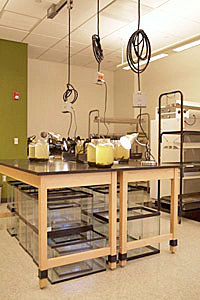
Project lab space includes movable furniture and utility connections that can be easily relocated.
As disciplinary barriers dissolve, labs and experimental spaces must increasingly adapt for a wider range of shared disciplines and sub disciplines. Too many buildings are designed only for current needs and technologies. More aggressive scheduling will support student population growth and curricular changes—and the buildings must be ready to adapt. Institutions should provide flex space for unexpected opportunities and future "sandbox" activities, and they must be able to add power, data, cooling and lab services beyond minimum requirements. Today's teaching laboratories must also support a wide variety of teaching and learning styles. Like great classrooms, labs require sophisticated instructional technologies and a quiet yet stimulating environment.
Flexible lab furniture is fundamental. It allows faculty to customize a room and enables students to configure themselves in groups of two to eight or engage in individual study. Reconfigurable, movable lab tables (connected to overhead carriers providing hard-wired power) support lectures, teamwork or demonstrations as well as write-up activities for hood- or bench-intensive work at the room's perimeter. Rolling carts allow computers, equipment or special setups to circulate through the room for rotating student teams or to be shared among multiple labs. Specialized mobile lab casework provides dedicated teaching stations, media equipment carts, demonstration tables, or handicapped-accessible workstations that dock out of the way when not needed.

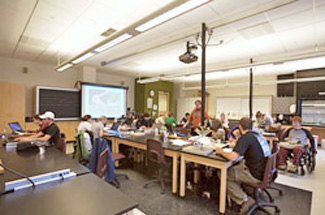
Movable tables in this organic chemistry lab allow students to set up documentation stations by team, close to fume hoods. (Winona State University).
Projected images from multiple sources, computer work at the lab tables, and specimen study occur simultaneously at the biology lab at Winona State University.
Research-ready labs require a robust technological infrastructure accessible on-demand for an unpredictable range of unique opportunities. In some cases all elements of a research setting may be on wheels or demountable. A leading example of this plug-and-play approach in a pure research setting is the Bio-X initiative at the James H. Clark Center at Stanford University. The building was planned for nearly any research use; no space was specific to a single use or discipline. All lab furniture is on wheels and can be docked to overhead services in any configuration desired.
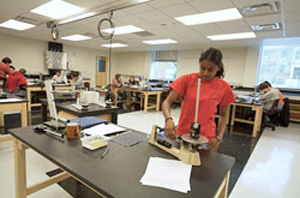
Multiple, flexible table configurations meet the needs of student teams and provide dedicated stations for equipment.
When used for instructional research, teaching labs must be easily reconfigurable to meet the changing demands of curriculum, grants, and industry and government partners. Labs not requiring water and piped gases at each student or research position often concentrate permanent casework and plumbing at the room's perimeter, with internal workstations comprised of movable tables and wheeled casework. Properties of fixed lab furniture (stability and vibration resistance) have been merging with properties of rolling/ adjustable computer furniture (mobility, plug and play capability, ability to reconfigure) to create a new type of furniture. This new breed addresses the need for computer connections to everything and allows the individual/team learning/discovery environment to be changed immediately, or moved to another space.
Structures and spaces must support the initial use, yet be adaptable to changes over the life of the building. A modular planning unit allows organized modifications to the building over time by setting the pattern for the lighting, power, mechanical air supply and exhaust system equipment and service points. The typical teaching lab planning module is based on a nominal 310– to 330–square–foot unit, a nominal dimension of 10–feet–4–inches by 31 feet. A typical structural bay for a teaching laboratory building is 20-feet-8-inches by 31 feet. Teaching labs for 16 to 18 students require 930 square feet of space; 1,240 square feet is needed for 20 to 24 students. These configurations allow at least 50 square feet per student and are proportioned to create safe, efficient spaces that can be served well with projectors. Upper-level labs may be 620 to 930 square feet with most individual prep/support areas allocated 310 square feet.
Projector screens and large writing surfaces set physical priorities for space arrangements in many teaching labs. Projector screens and the presentation writing surfaces are typically side by side so that students can see both simultaneously. Beyond the need for such fixed media delivery stations, the internal layout for the labs is limited only by the imagination. Typical teaching labs of 18 to 24 students can be served with a single large projector screen and writing surface. Labs of 1,550 square feet or more may require multiple projector screens and writing surfaces. Viewing angles and distance requirements are determining factors.
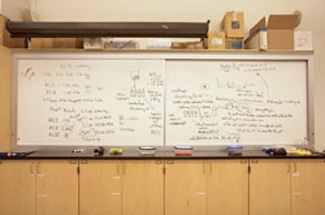
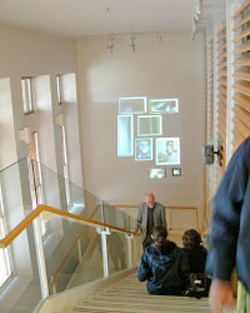
Projector screens work side by side with writing surfaces to deliver shared instructional information.
At Stanford University's Wallenberg Hall, students project their work on the wall in very public setting, using the stairs as a platform for collaboration.
Small Meeting/Discussion/Collaboration Rooms
It is best to locate open and closed spaces for small gatherings at important circulation intersections to be easily accessible and invite impromptu use. A combination of lounge-type seating and technology that facilitates brainstorming creates superb teaming rooms that promote comfort and ward off fatigue.
Quiet spaces for seminars, group study and project-based learning often feature large, flat-panel screens or projectors. Smart panels encourage high-touch participation as team members share the same work surface, collectively write over projected images, surf the Internet and communicate with a remote site, all while recording the interaction on the campus network for retrieval later. Projection and video technology allows viewing of multiple images from multiple sources. One or two walls might hold interactive digital displays (projected or "smart") while the other walls are full-height writing/ drawing surfaces. In all configurations, wires and wireless data connections are needed. Extremely agile furniture allows users to quickly customize the space.
Large Classrooms and Studio Labs
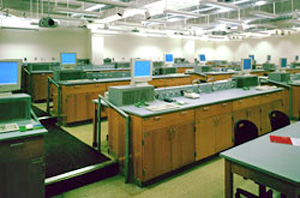
Lecture lab studios like this one at The State University of West Georgia allow for hands-on work and lecture for large classes.
In tiered, large volume (50–75 students) classrooms, each level holds two tables facilitating teams of two to four students. The chairs, and sometimes the tables, are moveable. To enable flexibility, smaller, single-level classrooms should be larger than called for by traditional planning models. Over time, the classrooms should be able to accommodate multiple screens and writing surfaces as well as various teaming and impromptu arrangements.
Special-purpose studio labs combine the best features of a tiered classroom with a bench-intensive lab. At the State University of West Georgia, a 64–student chemistry lecture theater includes an immediately accessible lab bench to enhance lectures.
Faculty Offices for Collaboration
Faculty offices also offer opportunities to enhance education. Office layouts may accommodate small projectors for wall display to allow students and faculty to share information without crowding around a monitor. Desktops have given way to laptops, laptops to tablet PCs. Often, multiple computer displays are in use simultaneously. Some faculty may prefer a simple worktable for collaboration while others choose a traditional desk arrangement. Office furniture should be highly flexible to serve a variety of individual work and collaboration styles.
Beyond facilitating shared resources, offices joined together in suites create a critical mass of activity that connects faculty members and disciplines. Dynamic clusters of offices, seminar rooms, and research and teaching labs focus communities in smaller units and create centers of collaboration with other clusters. In the most successful configurations, faculty has easy access to both teaching and research labs, and office clusters have clearly defined community spaces and intentional places for students and faculty to interact. Tutoring spaces with computers and physical models are often located near faculty suites to support students after class or lab.
Building Systems to Support Learning
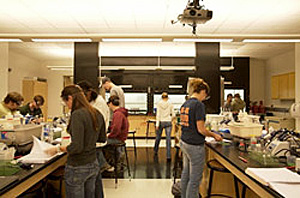
Glare-free indirect illumination provides visual comfort for bench and computer work while dramatically reducing energy costs.
Indirect light fixtures, which feature adaptable controls integrated into A/V systems, produce better light and reduce energy use. Lighting for labs, classrooms and offices is typically pendant-mount indirect with fluorescent T–5 high-output or super T–8 lamps. The glare-free illumination of the indirect systems allows foot-candle levels to be lower, in the 40-50 fc range, about half the traditional foot-candle requirement for labs. The lamps are often managed by occupancy sensors, daylight sensors and automatic progressive dimmers to provide a proper mix of artificial and natural light.
Zones in which individuals or smaller groups have control over their own thermal environment are more common, and operable windows are the norm in portions of buildings where fume control is not a factor. Comfort is greatly increased and energy costs are dramatically reduced.
The sound level in laboratories—including those with fume hoods—must be completely unobtrusive to facilitate conversations and collaboration if the space is to be used for pre-lab sessions and normal discussions. For proper speech recognition, 35dB(A) should be the design goal for background noise. An interesting reference for classroom acoustics is: OnlineDownload qc
Adaptable electrical and mechanical systems allow scientific equipment to be distributed in instrument rooms and across research and teaching labs. At Georgia Tech's Klaus Advanced Computing Building, a built-in central chilled water spine provides flexible connections for equipment cooling for a large portion of the building. This allows for laboratory space to be transformed to supercomputing/server zones with relative ease.
In teaching laboratories especially, imaging equipment and high-powered microscopes require vibration-resistant structural systems. The most damaging vibration is caused by students walking through the building, especially during class changes.
Additional Resources
Federal Agencies
- Department of Energy (DOE), Office of Environment, Health, Safety & Security
- For examples of facilities to support instruments of science, see DOE's Brookhaven National Laboratory
- Department of Veterans Affairs, Office of Construction & Facilities Management
- Environmental Protection Agency, Office of Administration and Resources Management
- General Services Administration, Office of Design and Construction: Office of the Chief Architect
- National Aeronautics and Space Administration, Facilities and Real Estate Division
- National Institutes of Health, Office of Research Facilities, Development and Operations developed the NIH Design Policy and Guidelines to provide standards to assist planners, architects, and engineers in designing biomedical and animal research facilities for the NIH.
Organizations/Associations
- Laboratories for the 21st Century (Labs21)—Sponsored by the U.S. Environmental Protection Agency and the U.S. Department of Energy, Labs21 is a voluntary program dedicated to improving the environmental performance of U.S. laboratories.
- A Design Guide for Energy-Efficient Research Laboratories—A reference that helps facility owners, managers, and designers apply energy-efficiency features in laboratories.
- Environmental Performance Criteria (EPC)—The Labs21 Environmental Performance Criteria is a rating system specifically designed for laboratory facilities. It builds on the U.S. Green Building Council's LEED® Green Building Rating System.
- Labs21 Design Process Manual—Includes a "quick reference" sustainable strategies checklist as well as links to key resources for each stage of the design process.
- Labs21 Tool Kit
- Labs21 Annual Conference Presentations Archive
- U.S. Green Building Council's LEED®—Because research facilities present a unique challenge for energy efficiency and sustainable design, the USGBC formed the LEED-AGL Committee to develop a guide that helps project teams apply LEED credits in the design and construction of laboratory facilities.
Publications
- ASHRAE 110 Method of Testing Performance of Laboratory Fume Hoods
- ASHRAE Handbook
- ASHRAE Laboratory Design Guide
- Biosafety in Microbiological and Biomedical Laboratories (BMBL) 5th Edition by U.S. Department of Health and Human Services, Centers for Disease Control and Prevention and National Institutes of Health. Washington, DC: U.S. Government Printing Office, December 2009.
- Building Type Basics for Research Laboratories, 2nd Edition by Daniel Watch. New York: John Wiley & Sons, Inc., 2008. ISBN# 978-0470163337.
- Guidelines for Planning and Design of Biomedical Research Laboratory Facilities by The American Institute of Architects, Center for Advanced Technology Facilities Design. Washington, D.C.: The American Institute of Architects, 1999.
- R&D Magazine—Provides information on a variety of topics related to laboratories. The R&D Lab of the Year award is presented annually to outstanding laboratory facilities throughout the United States.


